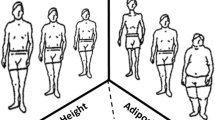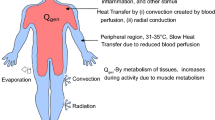Abstract
The assignments of basal metabolic rates (BMR), basal cardiac output (BCO), and basal blood perfusion rates (BBPR) were compared in nine multi-compartment, whole-body thermoregulation models. The data are presented at three levels of detail: total body, specific body regions, and regional body tissue layers. Differences in the assignment of these quantities among the compared models increased with the level of detail, in the above order. The ranges of variability in the total body BMR was 6.5 % relative to the lowest value, with a mean of 84.3 ± 2 W, and in the BCO, it was 8 % with a mean of 4.70 ± 0.13 l/min. The least variability among the body regions is seen in the combined torso (shoulders, thorax, and abdomen: ±7.8 % BMR and ±5.9 % BBPR) and in the combined head (head, face, and neck ±9.9 % BMR and ±10.9 % BBPR), determined by the ratio of the standard deviation to the mean. Much more variability is apparent in the extremities with the most showing in the BMR of the feet (±117 %), followed by the BBPR in the arms (±61.3 %). In the tissue layers, most of the bone layers were assigned zero BMR and BBPR, except in the shoulders and in the extremities that were assigned non-zero values in a number of models. The next lowest values were assigned to the fat layers, with occasional zero values. Skin basal values were invariably non-zero but involved very low values in certain models, e.g., BBPR in the feet and the hands. Muscle layers were invariably assigned high values with the highest found in the thorax, abdomen, and legs. The brain, lung, and viscera layers were assigned the highest of all values of both basal quantities with those of the brain layers showing rather tight ranges of variability in both basal quantities. Average basal values of the “time-seasoned” models presented in this study could be useful as a first step in future modeling efforts subject to appropriate adjustment of values to conform to most recently available and reliable data.







Similar content being viewed by others
References
Arkin H (1982) Application of a model of human temperature regulation to predict responses to local cooling Ph.D. Dissertation, Technion, Israel Institute of Technology, Haifa, Israel
Brooks GA, Fahey TD, White TP (1966) Exercise physiology—human bioenergetics and its applications, 2nd edn. Mayfield Pub. Co, Mountain View, p 43
Burton AC (1934) The application of the theory of heat to the study of energy metabolism. J Nutr 7:497–533
CBE (2001) Center for the Built Environment, University of California Berkeley, personal communication
Charny CK (1988) Bioheat transfer during therapeutic hyperthermia Ph.D. Dissertation, Johns Hopkins University, Baltimore, Maryland
Cooney DO (1976) Biomedical engineering principles—an introduction to fluid, heat and mass transport processes. Marcel Dekker Inc., New York
Eichna LW, Ashe WF, Bean WB, Shelly WB (1945) The upper limits of heat and humidity tolerated by acclimatized men working in hot environments. J Ind Hyg Toxicol 27:59–84
Fan LT, Hsu FT, Hwang CL (1971) A review on mathematical models of the human thermal system. IEEE Trans Biomed Eng BME-18:218–234
Fiala D (1998) Dynamic simulation of human heat transfer and thermal comfort Ph. D. Dissertation, Institute of Energy and Sustainable Development, De Montfort University, Leicester
Fiala D, Lomas KJ, Stohrer MA (1999) computer model of human thermoregulation for a wide range of environmental conditions: the passive system. J Appl Physiol 87:1957–1972
Fiala D, Lomas KJ, Stohrer M (2001) Computer prediction of human thermoregulatory and temperature responses to a wide range of environmental conditions. Int J Biometeorol 45:143–159
Gordon RG (1974) The response of a human temperature regulatory system model in the cold Ph.D. Dissertation, University of California, Santa Barbara
Gordon RG, Roemer RB, Horvath SM (1976) A mathematical model of the human temperature regulatory system-transient cold exposure response. IEEE Trans Biomed Eng BME-23:434–444
Hardy JD (1972) Models of temperature regulation—a review. In: Bligh J, Moore J (eds) Essays on temperature regulation. Elsevier/North-Holland, Amsterdam, pp 163–186
Huizenga C, Zhang H, Arens E (2001) A model of human physiology and comfort for assessing complex thermal environments. Build Environ 36(6):691–699
Hwang L, Konz SA (1977) Engineering models of the human thermoregulatory system—a review. IEEE Trans Biomed Eng BME-24(4):309–325
Kraning KK, Gonzalez RR (1997) A mechanistic computer simulation of human work in heat that accounts for physical and physiological effects of clothing, aerobic fitness, and progressive dehydration. J Therm Biol 22:331–342
Machle W, Hatch TF (1947) Heat: men’s exchanges and physiological responses. Physiol Rev 27:200–227
Montgomery LD (1974) A model of heat transfer in immersed man. Ann Biomed Eng 2:19–46
Morgan LW, Collett G, Cook DW (1970) Computer program documentation: transient metabolic simulation program, NASA Contract 9–5384
Smith CE (1991) A transient, three-dimensional model of the human thermal system. Ph.D. Dissertation, Kansas State University, Manhattan, Kansas
Spiegel RJ, Deffenbaugh DM, Mann JE (1980) A thermal model of the human body exposed to an electromagnetic field. Bioelectromagnetics 1:253–270
Stolwijk JAJ (1970) Mathematical model of thermoregulation. In: Hardy JD Gagge AP, Stolwijk JAJ (ed) Physiological and behavioral temperature regulation Springfield, Ill.:Thomas, p 703–721
Stolwijk JAJ (1971) A mathematical model of physiological temperature regulation in man. NASA Technical Report No. NASA CR-1855
Stolwijk JAJ, Hardy JD (1966) Temperature regulation in man—a theoretical study. Plügers Arch 291:129–162
Tanabe S-I, Kobayashi K, Nakano J, Ozeki Y, Konishi M (2002) Evaluation of thermal comfort using combined multi-node thermoregulation (65MN) and radiation models and computational fluid dynamics (CFD). Energy and Build 34(6):637–646
Tikuisis P, Gonzalez RR, Pandolf KB (1987) Human thermoregulatory model for whole body immersion in water at 20 and 28°C. US Army Res. Inst. Environ. Med., Natick, Ma. T23-87: 1–46
Tikuisis P, Gonzalez RR, Pandolf KB (1988a) Thermoregulatory model for immersion of humans in cold water. J Appl Physiol 64(2):719–727
Tikuisis P, Gonzalez RR, Pandolf KB (1988b) Prediction of human thermoregulatory responses and endurance time in water at 20 and 24°C. Aviat Space Environ Med 59:742–748
Werner J, Webb P (1993) A six cylinder model of human thermoregulation for general use on personal computers. Ann Physiol Anthropol 12(3):123–134
Wissler EH (1961) Steady state temperature distribution in man. J Appl Physiol 16:734–740
Wissler EH (1964) A mathematical model of the human thermoregulatory system. Bull Math Biphys 26:147–166
Wissler EH (1977) Simulation of thermal transients during deep diving. Defense Tech Info Ctr 14 pages
Wissler EH (1985) Mathematical simulation of human thermal behavior using whole-body models. In: Shitzer A, Eberhart RC (eds) Heat transfer in medicine and biology—analysis and applications, vol 1. Plenum Press, New York, pp 325–374
Wissler EH (1988) A review of human thermal models. In: Mekjavic IB, Banister EW, Morrison JB (eds) Environmental ergonomics. Taylor and Francis, London
Wissler EH (2010) Personal communication
Wolf MB, Garner RP (1997) Simulation of human thermoregulation during water immersion: application to an aircraft cabin water-spray system. Ann Biomed Eng 25:620–634
Yokoyama S, Maeda T, Kuramae M, Kakuta N (2007) Human thermal model expressing local characteristics of each segment (a review). J Human Environ Syst 10(2):51–61
Author information
Authors and Affiliations
Corresponding author
Appendices
Appendix 1
Appendix 2
Rights and permissions
About this article
Cite this article
Shitzer, A., Arens, E. & Zhang, H. Compilation of basal metabolic and blood perfusion rates in various multi-compartment, whole-body thermoregulation models. Int J Biometeorol 60, 1051–1064 (2016). https://doi.org/10.1007/s00484-015-1096-5
Received:
Revised:
Accepted:
Published:
Issue Date:
DOI: https://doi.org/10.1007/s00484-015-1096-5




